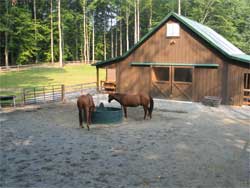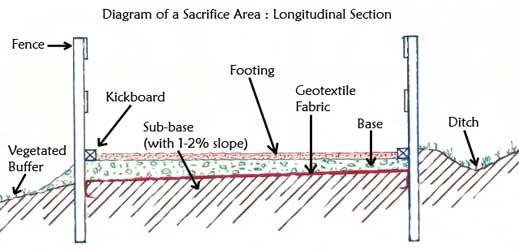 A sacrifice area, also known as a "pen," is an essential component of horse rotational grazing systems on small acreages. It is a relatively flat outdoor area on which no grass is expected to grow and which provides an alternative to pasturing. The area can be used for the horses' much needed daily exercise, and provides an alternative outlet for the animals during saturated soil or drought conditions. The sacrifice area can also be used when pastures are over-grazed or require maintenance. Including a sacrifice area in your horse operation will reduce soil loss and water pollution by preventing erosion and can save you time and money by decreasing pasture maintenance requirements.
A sacrifice area, also known as a "pen," is an essential component of horse rotational grazing systems on small acreages. It is a relatively flat outdoor area on which no grass is expected to grow and which provides an alternative to pasturing. The area can be used for the horses' much needed daily exercise, and provides an alternative outlet for the animals during saturated soil or drought conditions. The sacrifice area can also be used when pastures are over-grazed or require maintenance. Including a sacrifice area in your horse operation will reduce soil loss and water pollution by preventing erosion and can save you time and money by decreasing pasture maintenance requirements.
Poorly sited, constructed and/or managed sacrifice areas are vulnerable to erosion, and can become potential sources of non-point source pollution (e.g. from manure and urine) for surface and ground water. The following guidelines outline considerations associated with installation and maintenance of a sacrifice area.
Location and Sizing
In situations where horses are left unattended for many hours per day, the sacrifice area should be easily accessible to and from their stalls and equipped with watering and feeding amenities. Should the sacrifice area be located away from a barn or stall, then the horses should have access to shelter. A run-in shed, a three sided-structure with a roof that is large enough for the horses to enter and leave freely, is typically sufficient. An operation with multiple horses can have more than one sacrifice area—a large one next to the barn and additional smaller areas located within or next to larger fields. A gated access to a pasture from each sacrifice area makes for a "chore-efficient" operating system.
Areas that are on higher ground with a slight slope of 1-2 percent (for drainage) are ideal locations for sacrifice areas. Low spots, natural drainage areas, floodplains, and resource protection areas (RPAs) are poor locations for sacrifice areas. Consider relocating a sacrifice area if it is currently within these problem areas. Avoid areas with slopes (30 percent or greater) that are susceptible to erosion.
A sacrifice area can be of any shape. For one horse, an area can be as small as 14 feet by 24 feet. The basic rule of thumb is that a full-grown horse should be able to make convenient turns within the sacrifice area. If the area is to be sized for multiple horses, it should be large enough for a horse to easily get away if it is about to be cornered by a dominating stable mate. The size of a sacrifice area should be limited to just what is actually needed. The smaller the area, the less challenging it will be to manage its pollution.
Construction
- Grade an area to serve as the sub-base (the sub-base is the earth or native soil).
- Cover the sub-base with a sheet of geotextile fabric. Tuck the loose ends of the fabric into trenches along the perimeter. The fabric keeps the base material from sinking into the sub-base over time.
- Spread a base layer about six inches thick, consisting of a mix of three-fourths to 3-inch sized crushed igneous rock or limestone. The base is the layer of material between the native soil and the upper most layer on which the horses exercise. This gravel layer protects the area from erosion and enhances drainage within the site.
- Spread a layer of footing three to four inches thick (the final layer) to provide a comfortable "hoof-cushion." This should consist of any material that does not compact well such as sand, crusher run, rubber chunks, mulch or ground limestone. Ground limestone provides an advantage over other footing materials because it chemically neutralizes horse urine odor. Be careful not to use too fine a footing material as the footing will compact, reducing infiltration and causing ponding within the sacrifice area.
- Prevent wash-off of the footing material by installing kickboards made of railroad ties.
- To keep excess rain or melted snow from flowing through the sacrifice area, divert runoff around the sacrifice area by installing ditches, or connecting roof gutters to downspouts and piping the runoff around the area. Installation of a vegetated buffer to filter pollutants in runoff from the sacrifice area is also highly recommended.
- Locate the run-in shed structure at the corner of sacrifice area, so that roof runoff from this structure can be easily diverted from the sacrifice area. The shed should be oriented such that it provides protection for animals from winter's northerly and north-westerly winds.
- Use regular fencing to determine the size and shape of the sacrifice area.

ILLUSTRATION NOT TO SCALE
Maintenance
- Maintain a grass filter strip along the downslope sides of the heavy-use area. This will trap sediment and other pollutants in runoff.
- Remove manure, soiled bedding and uneaten feed daily, especially before a rain or snow event. Manure accumulation leads to mud problems because it retains water. Scrape off all manure before winter.
- Practice dust control measures. Sprinkle water on sacrifice areas to keep dust down during the dry summer months. This also will help prevent the accumulation of urine salts.
- New footing material may need to be added every two to three years.
Caution: To avoid ingestion of footing material by horses, always provide hay or feed in an elevated hay/feed dispenser.

